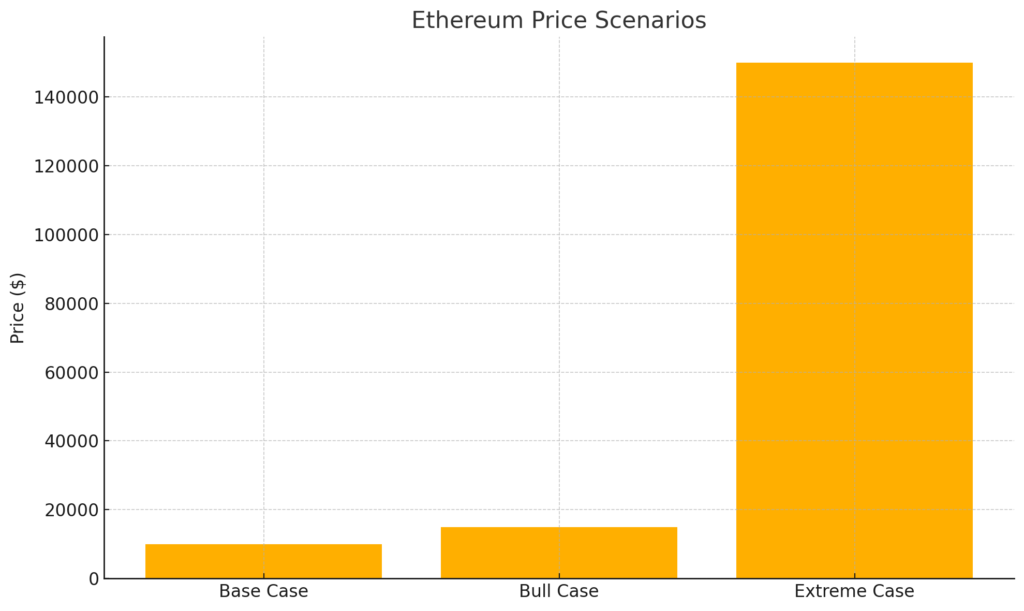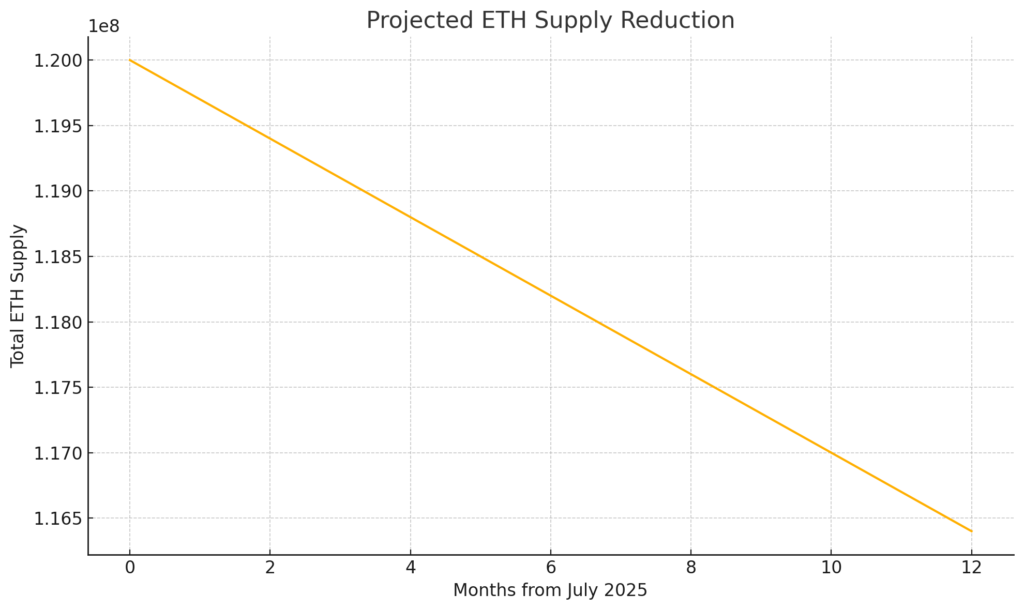
Main Points:
- Eric Jackson’s base case of $10,000, bull case of $15,000, and extreme case of $150,000 for ETH
- Potential approval of a staking-enabled Ethereum ETF by the U.S. SEC as early as October 2025
- Layer‑2 and Real‑World Asset (RWA) tokenization driving fee revenue and increased burn rates
- Institutional inflows via staking rewards distribution and in‑kind redemption mechanisms
- Recent developments: BlackRock’s in‑kind redemption filing, SEC delays for Grayscale, evolving regulatory landscape
- Projected supply reduction under deflationary issuance and its impact on price scenarios (see charts)
1. Jackson’s Three Pricing Scenarios for ETH
In a July 14 post on X (formerly Twitter), Eric Jackson, founder of EMJ Capital, outlined three distinct price trajectories for Ethereum (ETH):
- Base Case: $10,000 (¥1.48 million)
- Bull Case: $15,000 (¥2.22 million)
- Extreme Case: $150,000 (¥22.2 million)
Jackson argues that most market participants have mispriced Ethereum by focusing solely on spot demand, whereas the true value driver will be institutional-grade yield via ETFs that distribute staking rewards. His $10,000 base case assumes moderate ETF adoption; the $15,000 bull case requires stronger-than-expected L2 growth and ETF flows; while the $150,000 extreme case envisions an explosion of e‑commerce use cases and DeFi/NFT adoption.
2. Staking‑Enabled ETFs: The True Catalyst
While nine spot Ether ETFs launched after the SEC’s July 23, 2024 approval, they offer no yield to investors. Jackson maintains the real catalyst is a staking‑enabled Ethereum ETF. He forecasts SEC approval by October 2025, at which point:
- Institutional Flows: Traditional asset managers can buy an ETF that stakes on‑chain, capturing yield.
- Supply Reduction: ETH locked in staking cannot circulate, tightening supply.
- Reward Distribution: ETF share‑holders receive staking yields, mimicking bond‑like income.
This dynamic would convert ETH from “digital oil” into an “institutional‑grade yield product,” flipping the narrative that Bitcoin ETFs outshine Ethereum.
3. Layer‑2 and RWA Growth Driving Burn Rates
Beyond ETFs, Ethereum’s EIP‑1559 burn mechanism means higher transaction fees lead to more ETH removed from circulation. Key trends:
- Layer‑2 Expansion: Networks such as Arbitrum and Optimism have breached $1 billion daily volume, increasing L1 fee share even as computation moves off‑chain.
- RWA Tokenization: Real‑World Assets—ranging from real estate to art—that on‑chain token markets are growing, boosting transaction volume and thus burns.
- DeFi & NFT Demand: Rising TVL and NFT marketplace activity further elevates base fees.
The burn effect compounds with staking lock‑ups, underpinning Jackson’s deflationary thesis despite Ultra Sound Money data indicating a slight 0.112% annual inflation.
4. Institutional Mechanisms: In‑Kind Redemptions and Beyond
In May 2025, BlackRock amended its iShares Ethereum Trust (ETHA) S‑1 filing to include in‑kind creation and redemption—allowing institutions to swap ETH for ETF shares directly. This model:
- Reduces friction and market impact compared to cash-only ETFs
- Encourages large‑scale inflows
- Aligns ETF holdings with on‑chain staking positions
Meanwhile, Grayscale’s staking approval remains pending, with the SEC delaying a decision until October 2025. The combined approval of staking and in‑kind redemptions would radically increase institutional demand for ETH.
5. Regulatory Landscape and Future ETF Approvals
Looking beyond Ethereum:
- Broader Crypto ETF Wave: Under a potentially pro‑crypto administration in the U.S. from 2025, ETFs for Solana, XRP, and others may follow, though flows could be smaller than BTC/ETH.
- SEC Scrutiny: Questions linger over ETH’s classification (security vs. commodity), but recent spot ETF approvals signal regulatory acceptance.
- Global Competition: EU and Asia‑Pacific jurisdictions are exploring their own crypto ETF frameworks, potentially shifting flows regionally.
Institutional comfort with regulated products is steadily growing, setting the stage for the next phase of Ethereum’s adoption.
6. Projected Supply Reduction and Price Impact
Below are two illustrative charts:

- Figure 1: Price scenarios under Jackson’s thesis.
- Figure 2: Projected ETH supply reduction over 12 months, assuming a net burn of 0.3 million ETH per month alongside staking lock‑ups.

The interplay of reduced supply and rising demand underpins the bull and extreme cases, suggesting that even modest adoption of staking‑enabled ETFs could propel ETH beyond $10,000 within 12–18 months.
Conclusion
Eric Jackson’s analysis frames Ethereum not as mere “digital oil,” but as an income‑generating, institutional financial product poised for explosive growth. The approval of staking ETFs—coupled with in‑kind redemption mechanics, Layer‑2 network expansion, and RWA market maturation—creates a powerful confluence of reduced supply and increased institutional demand. While base case projections place ETH at $10,000 (¥2.22 million) or even into the five‑figure extreme. As the SEC’s October 2025 deadlines approach, market participants should watch ETF filings and network metrics closely—Ethereum’s next chapter may reshape the crypto landscape.

